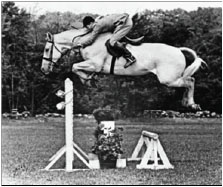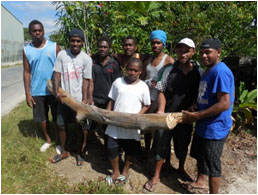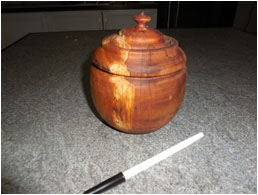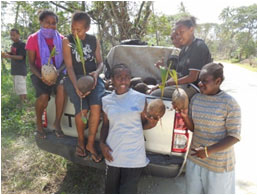Categories: All Articles, Creation, Individual, My Heart is Brim with Joy, Work
God’s Focus and Greatest Creation
In 1956 Harry de Leyer went to the auction to buy a horse for his children to ride. He got there too late. All the good horses had already been sold. A truck had been loaded with horses that were deemed good for nothing but to be sent to slaughter. Harry climbed up on the truck, looked at the horses, and saw a gray one with gentle eyes. He negotiated a deal with the owner, and purchased the horse for $80.
 It was snowing when Harry brought the horse home. The children named him snowman because of the snow on his back. The worn places on his hide and wounds on his legs showed that he had been worked hard as a plow horse. He was about 8 years old. He was gentle, and good with the children; but when a neighbor offered to buy him for $200, Harry sold him.
It was snowing when Harry brought the horse home. The children named him snowman because of the snow on his back. The worn places on his hide and wounds on his legs showed that he had been worked hard as a plow horse. He was about 8 years old. He was gentle, and good with the children; but when a neighbor offered to buy him for $200, Harry sold him.
Snowman apparently didn’t like it at the neighbor’s place. He kept coming back. No one could find where Snowman was getting out of his pasture. It was determined that he must be jumping the fence. The neighbor didn’t want him if he couldn’t keep Snowman in the pasture, so he sold him back to Harry.
Harry had always wanted a horse that could jump, but couldn’t pay the high price that would be required to buy a horse with a pedigree. Snowman liked to jump, so Harry decided to find out what he could do. Snowman enjoyed jumping. He was good at it. He was so good that Harry entered him in a jumping contest. Everyone laughed when the flea-bitten gray lined up with the pedigreed horses, but no one laughed when Snowman won the contest.
Snowman won the next contest, and the next. Snowman became famous. He became a model for what might be accomplished by ordinary things and people. Snowman was named Horse of the Year for 1956. He was named Horse of the Year in 1958 and 1959.
Snowman looked like an ordinary plow horse, but inside he was a champion.
 In preparation for a Young Single Adult conference in Vanuatu, I took eight young men and six young women out into the bush to gather coconuts and firewood with which food for the conference could be cooked.
In preparation for a Young Single Adult conference in Vanuatu, I took eight young men and six young women out into the bush to gather coconuts and firewood with which food for the conference could be cooked.
As the boys were chopping the firewood into shorter pieces, I saw something inside one of the sticks that no one else could see. I loaded that piece on the edge of the pile in the pickup so that I could use it later.
When we unloaded the firewood, I took a picture of the eight ordinary boys holding the ordinary stick. None of them was aware of what was inside the stick. Neither were any of them aware of what was inside themselves.
 I took the stick to the woodworking shop of my Scottish, Seventh-day Adventist friend who let me use his tools and lathe. Sweat ran down my head, and dripped from my chin as I worked to bring out the beautiful thing that I’d seen in the ordinary stick.
I took the stick to the woodworking shop of my Scottish, Seventh-day Adventist friend who let me use his tools and lathe. Sweat ran down my head, and dripped from my chin as I worked to bring out the beautiful thing that I’d seen in the ordinary stick.
My wife was shocked when I walked in the door after working in the shop. She said that I looked like I had fallen in the water, and rolled around in a pile of sawdust. I didn’t have the time to make the perfect piece that I’d imagined; but after three or four hours of work, I had created a lidded box.
 There is a great deal of satisfaction involved in creating things. Creating anything requires work. Only the creator knows how much thinking, planning, and hard work went into making the thing that he created. Only he can fully appreciate what has been accomplished.
There is a great deal of satisfaction involved in creating things. Creating anything requires work. Only the creator knows how much thinking, planning, and hard work went into making the thing that he created. Only he can fully appreciate what has been accomplished.
When I have finally finished building a fence, it gives me a great feeling of satisfaction to sight down the fence and admire the tight wires, and the straight line that I’ve made. When I write an article or a poem I read it over and over again making slight changes here and there until I have it perfect. Then I sit back and say to myself, “I did that! It’s beautiful. It’s as perfect as I can get it.”
In the Creation God created the Earth and the waters, and the scriptures say, “And I, God saw that all things which I had made were good.” (Moses 2:10). I think He stood back and admired what He had done.
And I, God, said: Let the earth bring forth grass, the herb yielding seed, the fruit tree yielding fruit…(and) every herb…and I, God, saw that all things which I had made were good. (Moses 2:11-12).
And I, God, created great whales, and every living creature that moveth, which the waters brought forth abundantly, after their kind, and every winged fowl after his kind; and I, God, saw that all things which I had created were good. (Moses 2:21).
And I, God, said: Let the earth bring forth the living creature after his kind, cattle, and creeping things, and beasts of the earth after their kind…and I, God, saw that all these things were good. (Moses 2:24-25).
And I, God, created man in mine own image, in the image of mine Only Begotten created I him;…And I, God, saw everything that I had made, and, behold, all things which I had made were very good. (Moses 2:27, 31).
I imagine God feeling great satisfaction, when after creating the earth and all things thereon, He then created man, His supreme creation. The very last thing that He made was the capstone: He made a woman, “and brought her unto the man.
And Adam said, This is now bone of my bones, and flesh of my flesh: she shall be call Woman. (Genesis 2:22-23).
And “…all things which (God) had made were very good.”
 God created all men. He knows what is inside them. The boys holding the ordinary stick in my picture thought they were ordinary sticks, too, but God knows what is inside them, just as I knew what was inside the stick. Those boys are His sons. They were created in His image. It is intended that they should grow up to be like Him. When He looks at them, he doesn’t see ordinary boys. He sees potential kings.
God created all men. He knows what is inside them. The boys holding the ordinary stick in my picture thought they were ordinary sticks, too, but God knows what is inside them, just as I knew what was inside the stick. Those boys are His sons. They were created in His image. It is intended that they should grow up to be like Him. When He looks at them, he doesn’t see ordinary boys. He sees potential kings.
I took six girls along on the wood-getting excursion to gather coconuts. Many of the coconuts had already sprouted. Within each coconut was a potential tree that could grow up and produce more coconuts just like it.
My wife has a favorite tree that we point out to each other as we pass. It is a coconut tree. She calls it “the repentance tree.” The first 20 feet of the trunk leans at a 45-degree angle, but then the trunk makes a 45-degree turn, and goes straight up for the next 20 feet. We imagine the tree going the wrong direction in its youth, but then repenting, and growing toward the light.
 Many of God’s children do the same thing. In fact, all of God’s children do that. Every living soul has sinned, must repent, and turn toward the light in order to achieve the potential that God has placed within him or her. Every son and daughter of God has the potential to grow up to become a king or a queen, a god or a goddess, just like their parent.
Many of God’s children do the same thing. In fact, all of God’s children do that. Every living soul has sinned, must repent, and turn toward the light in order to achieve the potential that God has placed within him or her. Every son and daughter of God has the potential to grow up to become a king or a queen, a god or a goddess, just like their parent.
Our Father is often referred to as the God of Abraham, Isaac, and Jacob. These were faithful men in mortality, and the scripture says, “…they have entered into their exaltation, according to the promises, and sit upon thrones, and are not angels but are gods.” (D&C 132:37).
Abraham, Isaac, and Jacob were shepherds. They were common, ordinary men that God saw as prophets. David was a shepherd, too—a common, ordinary boy. But God saw him as a king. He sent his prophet, Samuel, to the house of Jesse to find and anoint the new king from among Jesse’s eight sons. When Samuel saw Jesse’s son, Eliab, he said to himself, “Surely the Lord’s anointed is before (me).
“But the Lord said unto Samuel, Look not on his countenance, or on the height of his stature; because I have refused him: for the Lord seeth not as man seeth; for man looketh on the outward appearance, but the Lord looketh on the heart.” (1 Samuel 16:6-7).
“…Jesse made seven of his sons to pass before Samuel. And Samuel said unto Jesse, The Lord hath not chosen these.
“And Samuel said unto Jesse, Are here all thy children? And he said, There remaineth yet the youngest, and, behold, he keepeth the sheep. And Samuel said unto Jesse, Send and fetch him…And he sent, and brought him in…And the Lord said, Arise, anoint him: for this is he.” (1 Samuel 16:10-12).
David saw himself as a common, ordinary shepherd boy. Abraham, Isaac, and Jacob also saw themselves as common, ordinary shepherds. I used to own sheep. I was a shepherd, too. If Abraham, Isaac, and Jacob can make it, I can, too.
What does the Lord see in me that I can’t see? What does the Lord see inside the common, ordinary boys who were holding my stick? I saw something beautiful inside the stick that no one else could see. God looks upon our hearts, and sees things about ourselves that we’ve never imagined.
We are His greatest creations. Every coconut has the potential to grow up and become a unique, but perfect, tree. Every man, woman, boy, and girl has the potential to grow up, repent, and become like his and her parent. Each of us is unique, and each of us is special. We must not forget this.
